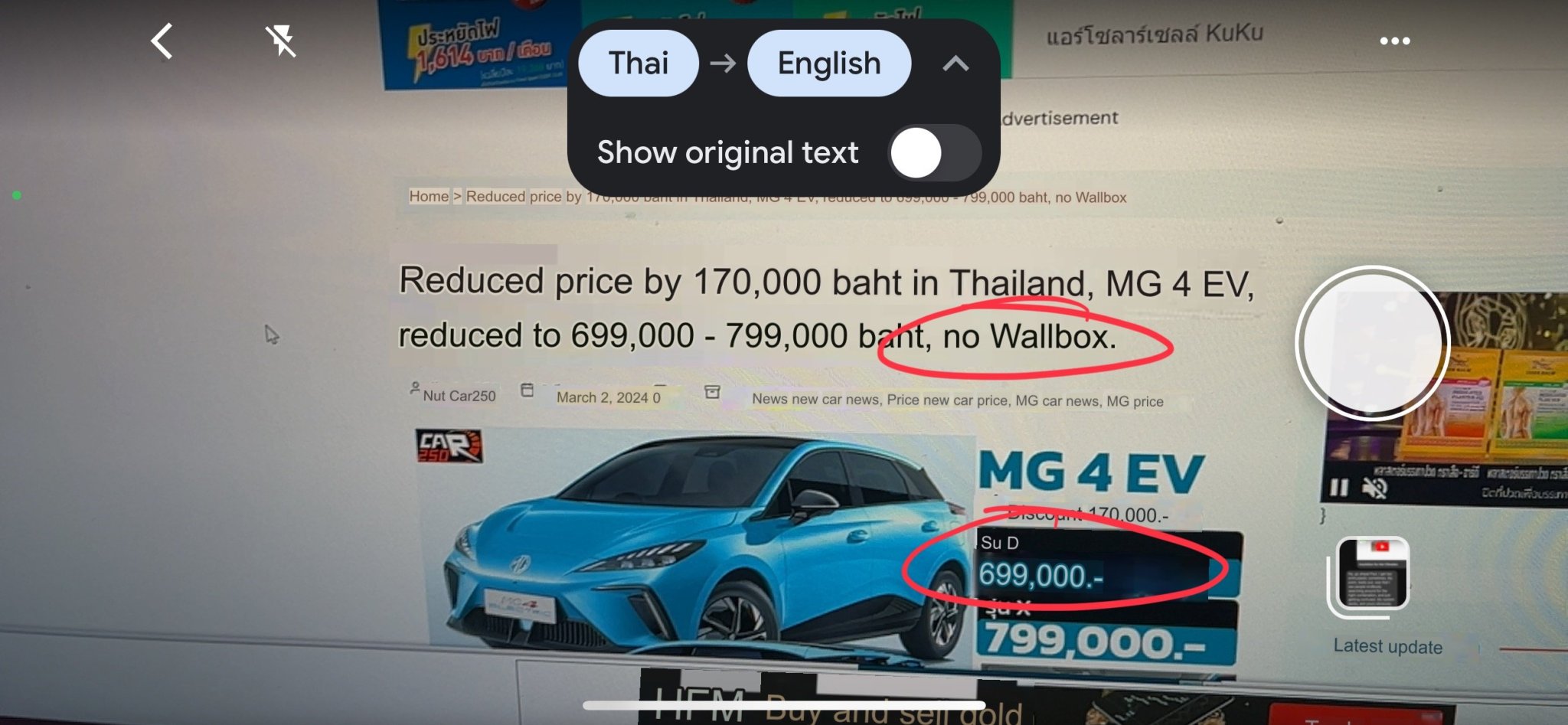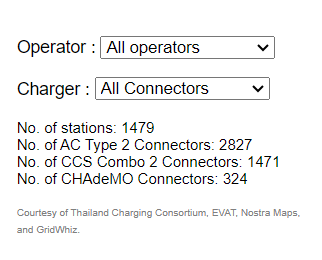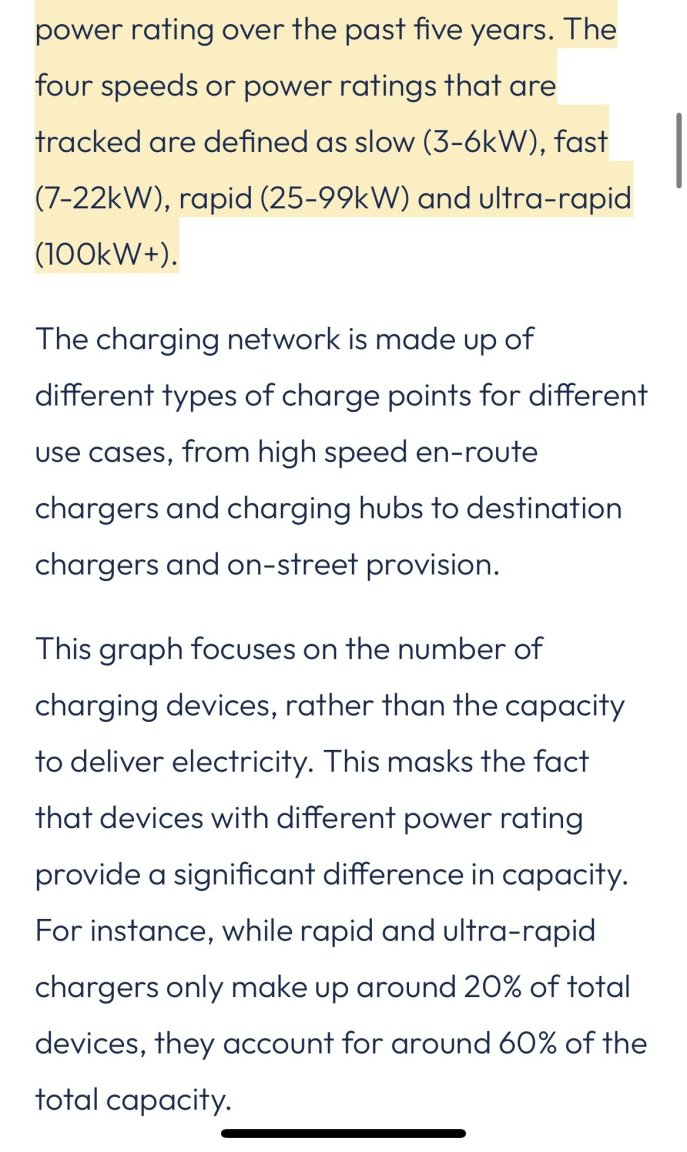
matchar
-
Posts
264 -
Joined
-
Last visited
Content Type
Profiles
Forums
Downloads
Posts posted by matchar
-
-
2 hours ago, KhunLA said:
Think you need to do a bit more homework, before posting

Or since you have no interest, maybe not post at all.
Here's your homework for today:
https://www.reddit.com/r/TeslaModel3/comments/1b7dr08/why_you_need_to_charge_lfp_to_100/
-
 1
1
-
 1
1
-
-
1 hour ago, KhunLA said:
Think you need to do a bit more homework, before posting

Or since you have no interest, maybe not post at all.
Childish as usual, didn't expect anything else from you.
-
 1
1
-
-
1 hour ago, KhunLA said:
But most LFP batteries charge much slower and they need balancing a lot more often than NMC so they are even more inconvenient if you can't charge at home.
-
 1
1
-
 1
1
-
-
14 minutes ago, JBChiangRai said:
I'm not sure whether you need to do that on NMC batteries, they recommend you only charge to 80% every time unless you're traveling a long distance, you have to tell the car to do that, it's not the default.
EV Pluz also have a 220v charging option so I guess she could do that if it's necessary.
I think NMC batteries require balancing about once a month and for me this would be quite inconvenient without a home charger.
If an equalisation charge has not been carried out for sometime, the message centre in the instrument pack will
display 'Please Slow-charge the Vehicle'.
-
1 hour ago, JBChiangRai said:
She only got the car 10 days ago, today was the second time she charged it, we went to a PTT and plugged it in, easy peasey, it took 30 minutes to go from 20% to 80%, her car is the performance variant with NMC batteries and you don't charge past 80% unless you're going on a long drive.
We had a coffee at Amazon and then ger phone pinged to say "Charging Complete"
IMHO, many people can easily function without a home charger.
What about when she needs to balance the battery? I believe this only works on slow chargers and you have to spend a long time charging to 100% and then allow extra time for the balancing.
-
- Popular Post
1 hour ago, Dellboy218 said:Furthermore, the PEA informs about the energy-saving advantages of modern inverter air conditioners since they cool rooms quickly and efficiently
An inverter aircon does not cool any quicker than a non inverter type. Equivalent size compressor units will or should cool the same although they may use different refrigerant gasses which may make a difference. Both types will use roughly the same electrical energy when running flat out, with similar sized compressor. Where an inverter can save electricity is on compessor start up. An induction motor as in the compressor can take around 7 times its running energy to start. So if your non inverter unit is set so that it is switching on and off constantly then it will be losing out to an inverter model. The inverter models don't have this problem. Inverters will also modulate up and down to maintain a steadier temperature rather than on/off.
I'm by no means an expert but I think while this is true, the startup spike is very brief so it's not as bad as it sounds and it won't contribute a significant amount of the overall energy usage.
The interesting question is when is it worth upgrading a perfectly working older fixed speed air conditioner to a newer inverter model?
I think in most cases it's worth keeping the old one until it dies.
-
 1
1
-
 2
2
-
4 hours ago, Ralf001 said:
Many many trucks here run on Natural Gas (NGV).
Unfortunately the government has done their best to discourage the use of NGV by incessantly raising the price...encouraging many to switch back to subsidised dirty diesel or LPG.
-
 1
1
-
-
22 hours ago, Niltava said:
This morning I did a test drive of the Volvo EX30 (Ultra, single motor, extended range).
This is the first time I have driven an EV and it was certainly a very impressive, refined car. The acceleration is quite something.
Talking to the sale rep, one thing that I was surprised to learn was that they claim that a replacement for the whole of the battery would cost about THB 80,000 (eighty thousand baht). I double checked with him about this, infact I triple checked and he said this was the right figure. He told me that the battery comes in 4 sections that can be replaced individually, each one costing about THB 20k. Can this be correct? I was under the impression that a EV battery makes up a substantial portion of the car's cost, so clearly this seems a bit odd.
N
Sounds like your typical Thai employee who is absolutely clueless about the product they are trying to sell.
I expect it's supposed to be 800,000 THB.
-
MG 4 updates ...now available in orange too.

Official price (Thai assembly)
Comes with campaign promotions as follows:
Guaranteed vehicle quality for 4 years or 120,000 km.
Battery warranty for 8 years or 180,000 km.
Free first class insurance for 1 year
Free 1 set of MG HOME CHARGER
Free installation fee for MG HOME CHARGER
Free 1 set of V2L cable
-
 1
1
-
-
I think EVs catching fire under normal usage is indeed very rare but when they are involved in a severe collision then the risk is much higher especially with NMC batteries.
LFP batteries are generally safer. I believe the Venice bus crash below used LFP batteries but the bus may have landed on high voltage train tracks which caused the batteries to explode.
https://www.bbc.com/news/world-europe-67001518
-
 1
1
-
-
Looks like the prices of all cars in Thailand are dropping like a stone...
https://autolifethailand.tv/discount-official-suzuki-ciaz-thailand/
150k discount on a brand new Suzuki Ciaz.
How long before you break even with the lower fuel costs on the MG 4 for the extra 300k?
-
34 minutes ago, Bandersnatch said:
Before we accuse anyone of "looking rather foolish" let's check if the poster has checked his facts before posting.
Back in September 2023 I posted that the MG4 D was selling for ฿ึ769k
So what is the new price?
฿ึ669k without a wall box. So we have a ฿ึ70k saving but you have to buy and install your own wallbox. So who is "looking rather foolish now"
Are you trying to tell me a wallbox is worth 70k baht? Let's say a rather generous 20k then it's still a 50k saving.
-
 2
2
-
-
https://www.car250.com/mg4-th-2024-1.html
Another price cut by MG as I expected.
All of the early adopters rushing to buy at the end of last year are looking rather foolish now...
-
 1
1
-
-
9 hours ago, josephbloggs said:
I wonder what their business model is. You can buy one for those kind of monthly prices.
They know they will have massive depreciation when a newer model comes out in a year or so that is cheaper, has a bigger battery and charges twice as fast.
-
- Popular Post
How stupid can Western governments get? Forcing Western companies to buy imaginary carbon credits from foreign companies...
Energy Absolute must be laughing all the way to the bank.
-
 4
4
-
 1
1
-
21 hours ago, Crossy said:
At 15 Baht a pop it's going to take BMA a while to pay off the 40 billion they currently owe BTSC!!
Let's hope they use some of that money to stop the monorail wheels and conductor rails falling off again!
-
35 minutes ago, Bandersnatch said:
I forget sometimes that I have to explain things like I speaking to a small child. My apologies let me make it a little clearer.There are 2 classes of chargers
They are sometimes known by how they are used:
Destination chargers: found at homes, places of work, shops, restaurants and hotels etc. They are used when the driver is going to be at a location for hours.
Road trip chargers: found on major highways, rest stops, fuel stations etc. They are used when the driver is stopping for minutes.
They are sometimes known by their connection type as @KhunLA explained above.
However they are probably most commonly known by the type of electricity they provide:
AC: EVs have an onboard inverter that converts AC power to DC to charge the batteries. Most cars can accept 7kW single phase and some can accept 11kW or even higher 3 phase.
DC: here both the EV’s capacity to accept a charge and charger capacity to deliver a charge can vary but the lower of the 2 speeds determines the charging speed.
Nobody is talking about AC/Destination charging here. We are discussing the speed of DC charging.
The fact that you clearly don’t know the difference shows just how difficult it is have an intelligent discussion about EVs with someone who has little of knowledge about them.
You said most of the chargers in Thailand are DC chargers but from the website you quoted there are:
2,827 Type 2 AC chargers
1,471 CCS DC chargers
Obviously there is only one small child here who doesn't know the definition of the word "most".
-
3 hours ago, Bandersnatch said:
I see you quoted my post comparing public charging in UK and Thailand, but you clearly didn’t read it.Let me try to simplify it for you:
UK: 90% of EV chargers slower than 20kW = long queue
Thailand: Most chargers faster than 100kW = no queue
When I charge at 150kW I can add 350km of range in 20 minutes.
I have never seen a queue at a charger in Thailand.
I only use a public charger when I’m traveling more than 600km
99% of the time I charge at home for free from my home solar.
Please look up the definition of the word "most" in a dictionary.
-
 1
1
-
-
You early adopters are in the golden age of EV charging.
It's only a matter of time until there are long queues for fast highway chargers like the UK is experiencing now (with the public charging cost higher than petrol).
-
 1
1
-
-
2 hours ago, Bandersnatch said:
One of the problems with owning an EV in Thailand is that you have to constantly fact-check critics who have no clue about actually owning an EV in Thailand. They ignorantly base their opinions on what they read from their home country and stupidly assume that everything is the exactly the same here in Thailand or probably worse.
Take for example public charging. In the UK the vast majority of public chargers are “slow” under 7kW or “fast” under 22kW. No wonder there are complaints about queues for chargers.
By comparison the vast majority of chargers in Thailand are the much newer “Ultra Rapid” 100kW+ with many 150kW+ which for my EV is an extra 350km of range added in just 20 minutes.
So how many fast DC chargers are available in Thailand? I think Thailand has the exact same problem as most of the public chargers I see in shopping malls etc are the slow AC type.
Even if there are plenty of fast DC chargers available now, at the current rate of EV sales I highly doubt the charging infrastructure will be able to keep up and it will be absolute carnage for longer weekend trips.
-
Has anyone tried using a car registration (blue) book as proof of address?
-
10 hours ago, DrJoy said:
Even if u have given them your TIN, you can earn only 20K thb per year
If the interest touches even 20,001 thb, then tax rate becomes 100 %
You will have to file PND 90 to get it back
A bit of a caution - you will have to declare all your income/savings /investments to the revenue department to be able to file PND 90 , to get your interest back
Surely it should be 15%?
SCB told me the tax deduction was 100% last month because they were collecting taxes on the 20K of interest I already received in June and October.
Hopefully at the end of this month the tax deduction will be a lot lower.
-
8 hours ago, ujayujay said:
And the price for the fool is now to spend the rest of his life in prison! Stupidity 2.0
He'll be out in a couple of years...TIT.
-
- Popular Post
- Popular Post
1 hour ago, KhunLA said:Not the best situation for owning an EV.
Does make me wonder why you even chime in on EV threads.
I follow this thread because I'm interested in EVs and I occasionally "chime in" to set the record straight when people like you try to compare apples with oranges and refuse to even consider the disadvantages of an EV.
You seem unwilling to enter into a balanced discussion weighing the pros and cons and you always try to cherry pick your figures like solar charging, top spec ICE price compared to lowest spec EV price etc. to support your arguments.
-
 3
3
-
 1
1
.png.3b3332cc2256ad0edbc2fe9404feeef0.png)








No charging option in condo - Need advice
in Thailand Motor Discussion
Posted
Why you need to charge LFP to 100%
Ok so I have seen many questions lately about LFP and charging to 100%.
The battery cells do not have an inherent requirement to be charged to 100%
The reason you should still charge to 100% at least once a week, is that the BMS (battery management system) will lose track over time of where the state of charge is.
Why does this happen then, and why don't the non-LFP batteries need it?
It comes down to the voltage curve.
LFP has a very flat curve, or in this extreme example of the attached photo, maybe even fluctuates up in the middle of the discharge curve. (Not very common, but illustrates the issue at hand)
This mean that the BMS cannot rely on voltage alone to determine SoC. However this then means that it has to use the Ah in and out to determine how much is left. The problem with this is that the available Ah also fluctuates with factors like temperature and discharge rate.
This is why you need to charge to 100%, to give the BMS a reliable point to start counting down from. As the battery is charged to full, the voltage spikes, and this tells the BMS that the battery is full.
NMC and most other lithium batteries have a more linear curve, which allows the BMS to use the voltage also to determine the current SoC, which negates the need for this calibration charge.
Hope this helps.
https://www.reddit.com/r/TeslaModel3/comments/1b7dr08/why_you_need_to_charge_lfp_to_100/
Updated especially for you already... you're welcome!